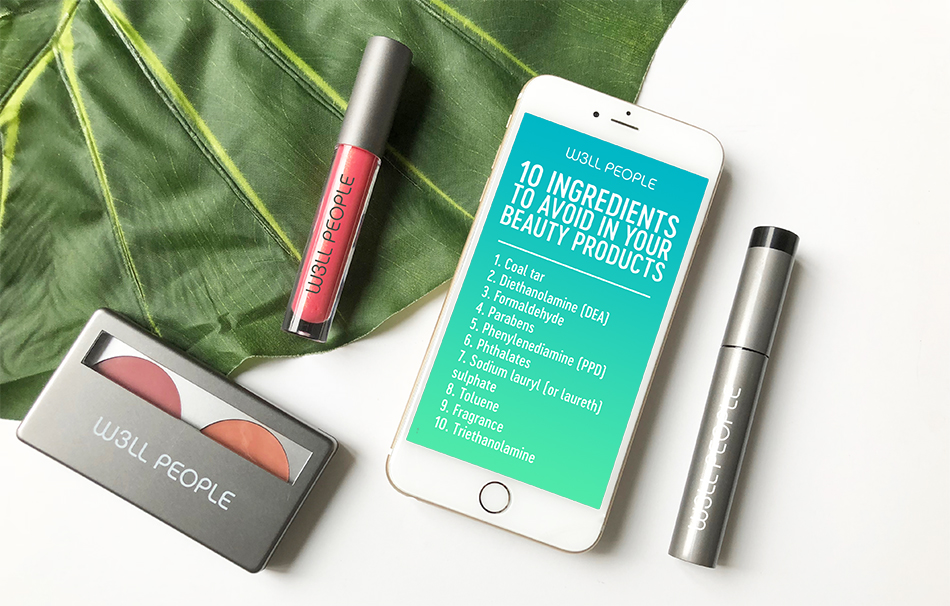
It’s no secret that there are products on the market that contain nasty ingredients known to cause everything from allergic reactions and skin sensitivities, to larger- more long-term problems such as hormone disruption and toxicity. Many of these toxic additives are even found to contribute to the development of cancer and other harmful diseases.
When asked why they are still using products that we know can be harmful, most people point their finger at the slack of knowledge about ingredients, and not knowing what to look for as a consumer to ensure that your products are safe and healthy.
It doesn't have to be overwhelming, and you don't have to be fooled anymore! Our team of experts have compiled 5 SIMPLE TIPS that will make it easy for you to stroll into the beauty aisle and confidently determine which products are safe, and which ones aren't deserving of a spot in your bathroom cupboard:
![]()
1. Don't judge a product by its cover.
Greenwashing is a real thing and many brands hide behind non-certified catch phrases like "organic" and "natural". Brands like to put these words right on the front of the packaging to help you make a decision. And although this may be helpful to you as a consumer, you also need to be somewhat skeptical. Especially if it is only the words "organic" or "natural". As our friend and green guru Paige Padgett notes in her book, The Green Beauty Rules, these words are not enough. Look for additional detail, such as cruelty-free, free of synthetics, or free of petrochemicals, and no matter what always turn the box over and look at the ingredient label to verify the quality of ingredients for yourself. Reputable brands are typically advocates for ingredient transparency. W3LL PEOPLE proves our dedication to this cause through the pioneering work we do with the Environmental Working Group, and the fact that we strive to have products that are EWG verified and USDA Certified Organic.
2. From the top to the bottom, my friend!
Ingredients are listed in order of concentration: from highest concentration to lowest concentration. So, if a product claims to be "coconut oil based", coconut oil should be the first thing on its ingredient label. This also means that if you're short on time, you can focus your efforts by researching and clearing the first 3-5 ingredients on a label, which will help verify that the majority of the formula is made with safe ingredients.
3. Memorize 10 words (or store this list in your phone).
You can't always run products through an app (although we love Think Dirty) or have uninterrupted access to an online database (we suggest EWG's Skin Deep), and sometimes small brands or new products aren't even listed. When that happens you'll need to determine whether a product is safe just like the old timers did: by using your memory! Fortunately, memorizing just 10 words can help you become pretty comfortable deciphering ingredients in cosmetics:
1. Coal tar
2. Diethanolamine (DEA)
3. Formaldehyde
4. Parabens
5. Phenylenediamine (PPD)
6. Phthalates
7. Sodium lauryl (or laureth) sulphate
8. Toluene
9. Fragrance
10. Triethanolamine
We've put together a Cheat Sheet that you can store in your phone when you're in a pinch! Click below to grab it!
If you see any of those words on the ingredient label, it is probably a product you want to avoid.
4. Beware of fragrance!
There's an FDA loophole that allows companies to conceal a long list of chemicals, often ones containing phthalates, as "fragrance". Fragrance, especially synthetic fragrance, is something that is good to avoid due to sensitivities, but is especially worth avoiding if a brand isn't disclosing what, exactly, makes up the "fragrance" they list on their ingredient label. Go for brands that are fragrance free, synthetic fragrance free, or use essential oils and list what oils are in each product.
5. Big words aren't always bad.
Many brands follow the INCI labeling standard, which requires that you list ingredients using their scientific name. This helps a lot with consistency across the industry, but can also make for a lot of long, hard to pronounce words that can scare consumers. A lot of brands (including us!) will use both the scientific name and the common name, just to help out the consumer. For example, you'll see Carthamus Tinctorius listed as an ingredient in some of our products. Carthamus Tinctorius is safflower seed oil, which we put in parenthesis. If the brand doesn't translate it for you, a quick google search will help you out. That said, the use of INCI can also make it easier for brands to sneak toxic ingredients into their products -- because their long, indecipherable names just blend right in! In this case, rely on our list of 10 Ingredient to Avoid that you memorized in Step 3!
Determining which products are safe and which ones are toxic doesn't need to be time consuming or overwhelming. Arm yourself with these 5 SIMPLE TIPS and you'll be a label reading queen in no time!
You can find our products in the beauty aisle at Whole Foods, Target, W3LLPEOPLE.com and independent retailers nationwide, check out our locations page to find us near you and #BEW3LL!


